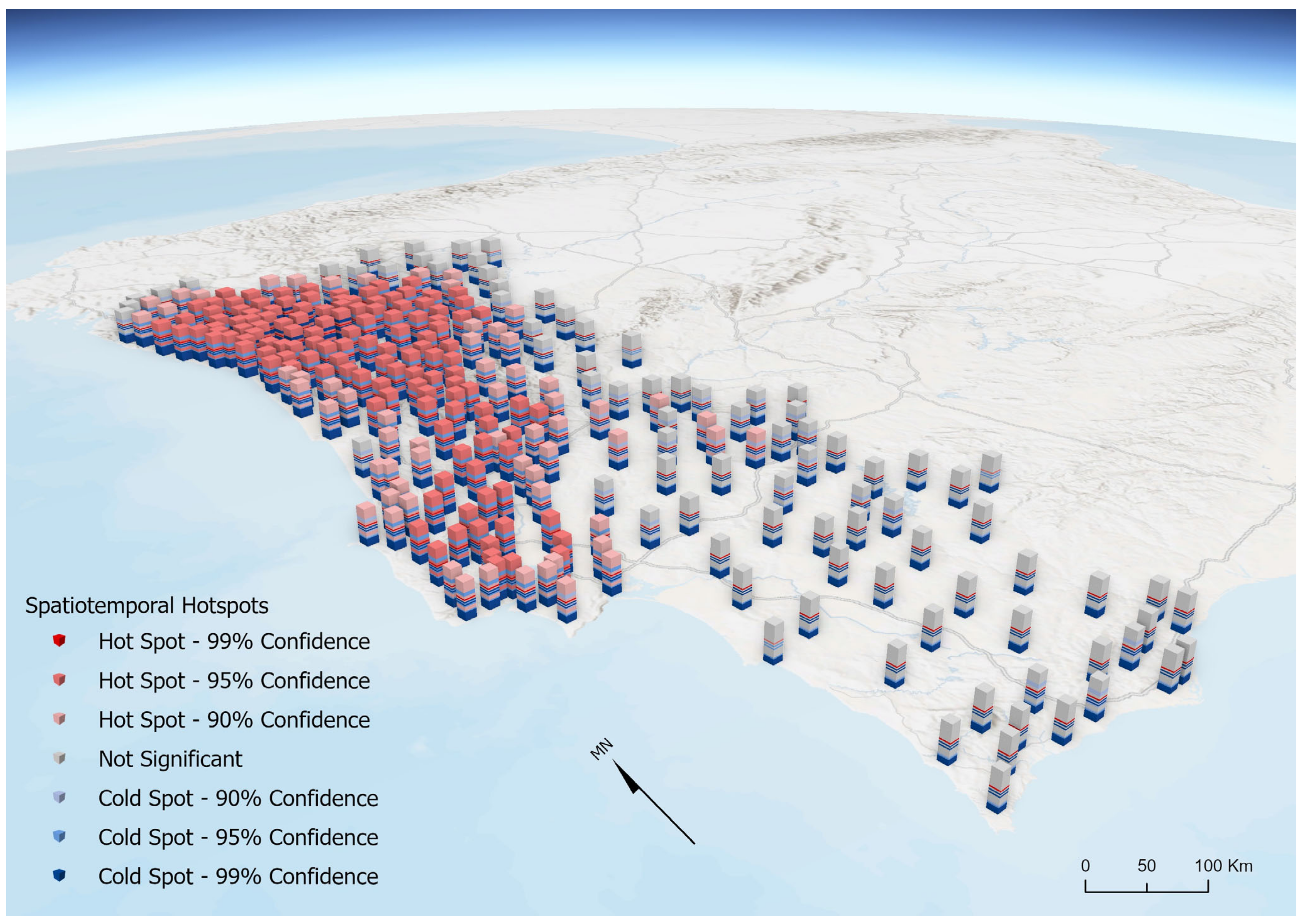Spatiotemporal Dynamics of COVID-19 Infections in Mainland Portugal
Abstract
:1. Introduction
1.1. Importance of Spatial and Spatiotemporal Analysis
1.2. Spatial Analysis Models
1.3. Spatiotemporal Analysis Models
2. Materials and Methods
2.1. Study Area
2.2. Data Collection and Processing
2.2.1. Global, Local, and Hybrid Spatial Analysis Models
2.2.2. Spatiotemporal Cluster Analysis
3. Results
3.1. Selected Important Dates for Spatial Analysis
3.2. Hotspot Analysis (Getis-Ord Gi*) with Inverse Euclidean Distance
3.3. Hotspot Analysis (Getis-Ord Gi*) with Commuting Weight Matrix
3.4. Cluster and Outlier Analysis—Anselin Local Moran’s
3.5. Hybrid Analysis
3.6. Spatiotemporal Cluster Analysis
4. Discussion
5. Conclusions
Author Contributions
Funding
Institutional Review Board Statement
Informed Consent Statement
Data Availability Statement
Acknowledgments
Conflicts of Interest
References
- Prem, K.; Liu, Y.; Russell, T.W.; Kucharski, A.J.; Eggo, R.M.; Davies, N.; Centre for the Mathematical Modelling of Infectious Diseases COVID-19 Working Group. The effect of control strategies to reduce social mixing on outcomes of the COVID-19 epidemic in Wuhan, China: A modelling study. Lancet Public Health 2020, 5, e261–e270. [Google Scholar] [CrossRef] [Green Version]
- WHO. WHO Director-General’s Opening Remarks at the Media Briefing on COVID-19. 2020. Available online: https://www.who.int/director-general/speeches/detail/who-director-general-s-opening-remarks-at-the-media-briefing-on-covid-19---11-march-2020 (accessed on 11 March 2020).
- Jebril, N. World Health Organization Declared a Pandemic Public Health Menace: A Systematic Review of the Coronavirus Disease 2019 “COVID-19”. SSRN Electron. J. 2020, 24, 2784–2795. [Google Scholar] [CrossRef]
- Kang, D.; Choi, H.; Kim, J.H.; Choi, J. Spatial epidemic dynamics of the COVID-19 outbreak in China. Int. J. Infect. Dis. 2020, 94, 96–102. [Google Scholar] [CrossRef] [PubMed]
- WHO. Weekly Epidemiological Update on COVID-19; World Health Organization: Geneva, Switzerland, 2020; Volume 1, p. 4. [Google Scholar]
- DGS. COVID-19 Relatório de Situação 27 December 2020; DGS: Lisbon, Portugal, 2020; pp. 68–69. [Google Scholar]
- UN. The Importance of Human Security in the Age of COVID-19; UN: New York, NY, USA, 2020. [Google Scholar]
- Swan, D.A.; Bracis, C.; Janes, H.; Moore, M.; Matrajt, L.; Reeves, D.B.; Burns, E.; Donnell, D.; Cohen, M.S.; Schiffer, J.T.; et al. COVID-19 vaccines that reduce symptoms but do not block infection need higher coverage and faster rollout to achieve population impact. Sci. Rep. 2021, 11, 15531. [Google Scholar] [CrossRef] [PubMed]
- SNS24. Temas da Saúde. Vacina COVID-19. 2021. Available online: https://www.sns24.gov.pt/tema/vacinas/programa-nacional-de-vacinacao/ (accessed on 15 April 2021).
- Klein, S.; Cortese, M.; Winter, S.L.; Wachsmuth-Melm, M.; Neufeldt, C.J.; Cerikan, B.; Stanifer, M.L.; Boulant, S.; Bartenschlager, R.; Chlanda, P. SARS-CoV-2 structure and replication characterized by in situ cryo-electron tomography. Nat. Commun. 2020, 11, 5885. [Google Scholar] [CrossRef]
- Hodcroft, E. CoVariants. Variants. 2021. Available online: https://covariants.org/variants/ (accessed on 15 February 2022).
- Vasireddy, D.; Vanaparthy, R.; Mohan, G.; Malayala, S.V.; Atluri, P. Review of COVID-19 Variants and COVID-19 Vaccine Efficacy: What the Clinician Should Know? J. Clin. Med. Res. 2021, 13, 317–325. [Google Scholar] [CrossRef]
- Timpka, T.; Ölvander, C.; Hallberg, N. Information system needs in health promotion: A case study of the Safe Community programme using requirements engineering methods. Health Inform. J. 2008, 14, 183–193. [Google Scholar] [CrossRef] [Green Version]
- Boulos, K.; Maged, N.; Geraghty, E.M. Geographical tracking and mapping of coronavirus disease COVID-19/severe acute respiratory syndrome coronavirus 2 (SARS-CoV-2) epidemic and associated events around the world: How 21st century GIS technologies are supporting the global fight against outbr. Int. J. Health Geogr. 2020, 19, 8. [Google Scholar] [CrossRef] [Green Version]
- Glass, G.E. Update: Spatial aspects of epidemiology: The interface with medical geography. Epidemiol. Rev. 2000, 22, 136–139. [Google Scholar] [CrossRef] [Green Version]
- Ribeiro, A.I.; Santos, C.J. The importance of spatial analysis of COVID-19 pandemic for health geography: Challenges and perspectives. Finisterra 2020, 55, 37–42. [Google Scholar]
- Pfeiffer, D.U.; Robinson, T.P.; Stevenson, M.; Stevens, K.B.; Rogers, D.J.; Clements, A.C.A. Spatial Analysis in Epidemiology; Oxford University Press: Oxford, UK, 2008; p. 142. [Google Scholar]
- Mollalo, A.; Mohammadi, A.; Mavaddati, S.; Kiani, B. Spatial Analysis of COVID-19 Vaccination: A Scoping Review. Int. J. Environ. Res. Public Health 2021, 18, 12024. [Google Scholar] [CrossRef] [PubMed]
- Raymundo, C.E.; Oliveira, M.C.; de Araujo Eleuterio, T.; André, S.R.; da Silva, M.G.; da Silva Queiroz, E.R.; Medronho, R.D.A. Spatial analysis of COVID-19 incidence and the sociodemographic context in Brazil. PLoS ONE 2021, 16, e0247794. [Google Scholar] [CrossRef] [PubMed]
- Cordes, J.; Castro, M.C. Spatial analysis of COVID-19 clusters and contextual factors in New York City. Spat. Spatiotemporal Epidemiol. 2020, 34, 100355. [Google Scholar] [CrossRef] [PubMed]
- Dutta, I.; Basu, T.; Das, A. Spatial analysis of COVID-19 incidence and its determinants using spatial modeling: A study on India. Environ. Chall. 2021, 4, 100096. [Google Scholar] [CrossRef]
- MohammadEbrahimi, S.; Mohammadi, A.; Bergquist, R.; Dolatkhah, F.; Olia, M.; Tavakolian, A.; Pishgar, E.; Kiani, B. Epidemiological characteristics and initial spatiotemporal visualisation of COVID-19 in a major city in the Middle East. BMC Public Health 2021, 21, 1373. [Google Scholar] [CrossRef]
- Mohammadi, A.; Mollalo, A.; Bergquist, R.; Kiani, B. Measuring COVID-19 vaccination coverage: An enhanced age-adjusted two-step floating catchment area model. Infect. Dis. Poverty 2021, 10, 118. [Google Scholar] [CrossRef]
- Ghosh, P.; Cartone, A. A Spatio-temporal analysis of COVID-19 outbreak in Italy. Reg. Sci. Policy Pract. 2020, 12, 1047–1062. [Google Scholar] [CrossRef]
- Sartorius, B.; Lawson, A.B.; Pullan, R.L. Modelling and predicting the spatio-temporal spread of COVID-19, associated deaths and impact of key risk factors in England. Sci. Rep. 2021, 11, 5378. [Google Scholar] [CrossRef]
- Sahu, S.K.; Böhning, D. Bayesian Spatio-Temporal Joint Disease Mapping of COVID-19 Cases and Deaths in Local Authorities of England. Spat Stat. 2022, 49, 100519. [Google Scholar] [CrossRef]
- Yang, W.; Deng, M.; Li, C.; Huang, J. Spatio-temporal patterns of the 2019-ncov epidemic at the county level in Hubei province, china. Int. J. Environ. Res. Public Health 2020, 17, 2563. [Google Scholar] [CrossRef] [Green Version]
- Purwanto, P.; Utaya, S.; Handoyo, B.; Bachri, S.; Astuti, I.S.; Sastro, K.; Aldianto, Y.E. Spatiotemporal analysis of COVID-19 spread with emerging hotspot analysis and space-time cube models in East Java, Indonesia. ISPRS Int. J. Geo-Inf. 2021, 10, 133. [Google Scholar] [CrossRef]
- Mo, C.; Tan, D.; Mai, T.; Bei, C.; Qin, J.; Pang, W.; Zhang, Z. An analysis of spatiotemporal pattern for COIVD-19 in China based on space-time cube. J. Med. Virol. 2020, 92, 1587–1595. [Google Scholar] [CrossRef] [PubMed] [Green Version]
- Huang, Z. Spatiotemporal evolution patterns of the COVID-19 pandemic using space-time aggregation and spatial statistics: A global perspective. ISPRS Int. J. Geo-Inf. 2021, 10, 519. [Google Scholar] [CrossRef]
- Koehrsen, W. Towards Data Science. The Poisson Distribution and Poisson Process Explained. 2019. Available online: https://towardsdatascience.com/the-poisson-distribution-and-poisson-process-explained-4e2cb17d459 (accessed on 15 February 2022).
- Miller, H.J. Tobler’s first law and spatial analysis. Ann. Assoc. Am. Geogr. 2004, 94, 284–289. [Google Scholar] [CrossRef]
- Portuguese Republic. Portal Diplomático. Representação Permanente de Portugal Junto da União Europeia. 2020. Available online: https://ue.missaoportugal.mne.gov.pt/pt/portugal/sobre-portugal/dados-gerais (accessed on 15 February 2022).
- INE. População Residente (N.o) por Local de Residência (Resultados Preliminares Censos 2021) e Sexo; Decenal. 2021. Available online: https://www.ine.pt/xportal/xmain?xpid=INE&xpgid=ine_indicadores&contecto=pi&indOcorrCod=0010745&selTab=tab0 (accessed on 22 February 2022).
- Azevedo, A.B.; Gomes, C.S.; Mendes, M.F.; Baptista, M.I.; Cabral, M.V.; Dinâmicas Demográficas e Envelhecimento da População Portuguesa (1950–2011): Evolução e Perspectivas. Fundação Francisco Manuel dos Santos: Lisbon, Portugal, 2014. Available online: https://www.ffms.pt/FileDownload/3b046d5a-0a4a-4e0e-9efb-3b3a7c87b616/dinamicas-demograficas-e-envelhecimento (accessed on 2 February 2022).
- INE. Estatísticas do Turismo 2020; Instituto Nacional de Estatistica: Lisbon, Portugal, 2021. Available online: https://www.ine.pt/ngt_server/attachfileu.jsp?look_parentBoui=567575902&att_display=n&att_download=y (accessed on 1 January 2022).
- INE. Dormidas (N.o) nos Estabelecimentos de Alojamento Turístico por Localização Geográfica (NUTS-2013) e Segmento (Alojamento Turístico); Mensal. 2021. Available online: https://www.ine.pt/xportal/xmain?xpid=INE&xpgid=ine_indicadores&indOcorrCod=0010735&contexto=bd&selTab=tab2 (accessed on 15 February 2022).
- DGS. Ponto de Situação Atual em Portugal. 2020. Available online: https://covid19.min-saude.pt/ponto-de-situacao-atual-em-portugal/ (accessed on 15 February 2022).
- Welch, B.L. The generalisation of student’s problems when several different population variances are involved. Biometrika 1947, 34, 28–35. [Google Scholar]
- Barbosa, B.; Rocha, J.; Costa, H.; Caetano, M. Automatic detection of vegetation cover changes in urban-rural interface areas. MethodsX 2022, 9, 101643. [Google Scholar] [CrossRef]
- Andersen, L.M.; Harden, S.R.; Sugg, M.M.; Runkle, J.D.; Lundquist, T.E. Analyzing the spatial determinants of local COVID-19 transmission in the United States. Sci. Total Environ. 2021, 754, 142396. [Google Scholar] [CrossRef]
- Mourao, P.; Bento, R. Explaining COVID-19 contagion in Portuguese municipalities using spatial autocorrelation models. Rev. Galega Econ. 2021, 30, 1–12. [Google Scholar] [CrossRef]
- Tang, W.; Liao, H.; Marley, G.; Wang, Z.; Cheng, W.; Wu, D.; Yu, R. The Changing Patterns of Coronavirus Disease 2019 (COVID-19) in China: A Tempogeographic Analysis of the Severe Acute Respiratory Syndrome Coronavirus 2 Epidemic. Clin. Infect. Dis. 2020, 71, 818–824. [Google Scholar] [CrossRef]
- Andrade, L.A.; Gomes, D.S.; Góes, M.A.d.O.; de Souza, M.S.F.; Teixeira, D.C.P.; Ribeiro, C.J.N.; Alves, J.A.B.; de Araújo, K.C.G.M.; Santos, A.D.d. Surveillance of the first cases of COVID-19 in Sergipe using a prospective spatiotemporal analysis: The spatial dispersion and its public health implications. Rev. Soc. Bras. Med. Trop. 2020, 53, e20200287. [Google Scholar] [CrossRef]
- Savini, L.; Candeloro, L.; Calistri, P.; Conte, A. A Municipality-Based Approach Using Commuting Census Data to Characterize the Vulnerability to Influenza-Like Epidemic: The COVID-19 Application in Italy. Microorganisms 2020, 8, 911. [Google Scholar] [CrossRef] [PubMed]
- Fatima, M.; O’Keefe, K.J.; Wei, W.; Arshad, S.; Gruebner, O. Geospatial Analysis of COVID-19: A Scoping Review. Int. J. Environ. Res. Public Health 2021, 18, 2336. [Google Scholar] [CrossRef] [PubMed]
- Sun, F.; Matthews, S.A.; Yang, T.C.; Hu, M.H. A spatial analysis of the COVID-19 period prevalence in U.S. counties through 28 June 2020: Where geography matters? Ann. Epidemiol. 2020, 52, 54–59.e1. [Google Scholar] [CrossRef] [PubMed]
- Anselin, L. Local Spatial Autocorrelation (2). Other Local Spatial Autocorrelation Statistics. 2020. Available online: https://geodacenter.github.io/workbook/6b_local_adv/lab6b.html#getis-ord-statistics (accessed on 15 February 2022).
- Cliff, A.D.; Ord, J.K.; Haggett, P.; Versey, G.R. Spatial Diffusion: An Historical Geography of Epidemics in an Island Community. N. Z. Geographer. 1981, 38, 91–92. [Google Scholar]
- Abler, R.; Adams, J.S.; Gould, P. Spatial Organization: The Geographer’s View of the World; Prentice/Hall International Editions; Prentice-Hall: Hoboken, NJ, USA, 1971. [Google Scholar]
- Gould, P.R. The Slow Plague: A Geography of the AIDS Pandemic; Wiley: Hoboken, NJ, USA, 1993. [Google Scholar]
- Gould, P.R. Spatial Diffusion, Resource Paper No. 4; National Science Foundation: Washington, DC, USA, 1969.
- Anselin, L. Local Indicators of Spatial Association—LISA. Geogr. Anal. 1995, 27, 93–115. [Google Scholar] [CrossRef]
- Getis, A.; Ord, J.K. The Analysis of Spatial Association by Use of Distance Statistics. Geogr. Anal. 1992, 24, 189–206. [Google Scholar] [CrossRef]
- Getis, A. Spatial Autocorrelation. In Handbook of Applied Spatial Analysis; Fischer, M., Getis, A., Eds.; Springer: Berlin/Heidelberg, Germany, 2010. [Google Scholar]
- Getis, A.; Cliff, A.D.; Ord, J.K. 1973: Spatial autocorrelation. Lond. Pion. Prog. Hum. Geogr. 1995, 19, 245–249. [Google Scholar] [CrossRef]
- Anselin, L.; Piras, G. Approaches towards the Identification of Patterns in Violent Events, Baghdad, Iraq. 2009. Available online: http://hdl.handle.net/11681/13859 (accessed on 15 February 2022).
- El Deeb, O. Spatial Autocorrelation and the Dynamics of the Mean Center of COVID-19 Infections in Lebanon. Front. Appl. Math. Stat. 2021, 6, 620064. [Google Scholar] [CrossRef]
- Wang, Q.; Dong, W.; Yang, K.; Ren, Z.; Huang, D.; Zhang, P.; Wang, J. Temporal and spatial analysis of COVID-19 transmission in China and its influencing factors. Int. J. Infect. Dis. 2021, 105, 675–685. [Google Scholar] [CrossRef]
- Saffary, T.; Adegboye, O.A.; Gayawan, E.; Elfaki, F.; Kuddus, M.A.; Saffary, R. Analysis of COVID-19 Cases’ Spatial Dependence in US Counties Reveals Health Inequalities. Front. Public Health 2020, 8, 579190. [Google Scholar] [CrossRef]
- Malczewski, J. Exploring spatial autocorrelation of life expectancy in Poland with global and local statistics. GeoJournal 2010, 75, 79–92. [Google Scholar] [CrossRef]
- Abdulhafedh, A. A Novel Hybrid Method for Measuring the Spatial Autocorrelation of Vehicular Crashes: Combining Moran’s Index and Getis-Ord Gi Statistic. Open J. Civ. Eng. 2017, 7, 208–221. [Google Scholar] [CrossRef] [Green Version]
- Tobler, W.R. A Computer Movie Simulating Urban Growth in the Detroit Region. Econ. Geogr. 1970, 46, 234–340. [Google Scholar] [CrossRef]
- Jacquez, G.M. Spatial analysis in epidemiology: Nascent science or a failure of GIS? J. Geogr. Syst. 2000, 2, 91–97. [Google Scholar] [CrossRef]
- Sabel, C.E.; Pringle, D.; Schærström, A. Infectious Disease Diffusion. In A Companion to Health and Medical Geography; Wiley Online Books; Wiley: New York, NY, USA, 2009; pp. 111–132. [Google Scholar]
- Hamed, K. Exact Distribution of the Mann-Kendall Trend Test Statistic for Persistence Data. J. Hydrol. 2009, 365, 86–94. [Google Scholar] [CrossRef]
- Kendall, M.G.; Dickinson, G.J. Rank Correlation Methods, 5th ed.; Griffin: London, UK, 1990. [Google Scholar]
- Mann, H.B. Nonparametric Tests against Trend. Econometrica 1945, 13, 245–259. [Google Scholar] [CrossRef]
- Pohlert, T. Trend: Non-Parametric Trend Tests and Change-Point Detection. 2020. Available online: https://cran.r-project.org/web/packages/trend/ (accessed on 22 November 2021).
- Portuguese Republic. Governo-Comunicados do Conselho de Ministros. Comunicado do Conselho de Ministros Extraordinário de 31 de Outubro de 2020. 2020. Available online: https://www.portugal.gov.pt/pt/gc22/governo/comunicado-de-conselho-de-ministros?i=378 (accessed on 10 December 2020).
- Eportugal. Medidas do novo Estado de Emergência. 2020. Available online: https://eportugal.gov.pt/noticias/medidas-do-novo-estado-de-emergencia (accessed on 2 May 2021).
- Huang, Y.; Yang, S.; Zou, Y.; Su, J.; Wu, C.; Zhong, B.; Jia, P. Spatiotemporal epidemiology of COVID-19 from an epidemic course perspective. Geospat. Health 2022, 17. [Google Scholar] [CrossRef]
- Li, Y.; Li, M.; Rice, M.; Zhang, H.; Sha, D.; Li, M.; Su, Y.; Yang, C. The Impact of Policy Measures on Human Mobility, COVID-19 Cases, and Mortality in the US: A Spatiotemporal Perspective. Int. J. Environ. Res. Public Health 2021, 18, 996. [Google Scholar] [CrossRef]
- Cheng, T.; Adepeju, M. Modifiable Temporal Unit Problem (MTUP) and Its Effect on Space-Time Cluster Detection. PLoS ONE 2014, 9, e100465. [Google Scholar] [CrossRef] [Green Version]
- DGS. COVID-19—Relatórios de Situação [National Health Delegation-COVID19 Daily Reports]. 2020. Available online: https://covid19.min-saude.pt/relatorio-de-situacao/ (accessed on 15 February 2021).
- Nathan, M. The city and the virus. Urban Stud. 2021, 17. [Google Scholar] [CrossRef]
- Marques, T.S.; Santos, H.; Honório, F.; Ferreira, M.; Ribeiro, D.; Torres, M. O mosaico territorial do risco ao contágio e à mortalidade por COVID-19 em Portugal Continental. Finisterra 2020, 55, 19–26. [Google Scholar]
- Dowd, J.B.; Andriano, L.; Brazel, D.M.; Rotondi, V.; Block, P.; Ding, X.; Liu, Y.; Mills, M.C. Demographic science aids in understanding the spread and fatality rates of COVID-19. Proc. Natl. Acad. Sci. USA 2020, 117, 9696–9698. [Google Scholar] [CrossRef] [PubMed] [Green Version]
- Barbosa, B.; Silva, M.; Capinha, C.; Garcia, R.A.C.; Rocha, J. Spatial correlates of COVID-19 first wave across continental Portugal. Geospat. Health 2022, 17. [Google Scholar] [CrossRef] [PubMed]
- Almendra, R.; Santana, P.; Santurtún, A.; Fdez-Arroyabe, P. COVID-19 Spread in the Iberian Peninsula during the “First Wave”: Spatiotemporal Analysis BT-Coronavirus (COVID-19) Outbreaks, Environment and Human Behaviour: International Case Studies; Akhtar, R., Ed.; Springer International Publishing: Cham, Switzerland, 2021; pp. 269–282. [Google Scholar]
- Almendra, R.; Santana, P.; Costa, C. Spatial inequalities of COVID-19 incidence and associated socioeconomic risk factors in Portugal. Bol. Asoc. Geogr. Esp. 2021, 91. [Google Scholar] [CrossRef]
- Moniz, M.; Soares, P.; Nunes, C. COVID-19 Transmission Dynamics: A Space-and-Time Approach. Port. J. Public Health 2020, 38 (Suppl. 1), 4–10. [Google Scholar] [CrossRef]
- Cheng, Y.; Ma, N.; Witt, C.; Rapp, S.; Wild, P.S.; Andreae, M.O.; Pöschl, U.; Su, H. Face masks effectively limit the probability of SARS-CoV-2 transmission. Science 2021, 372, 1439–1443. [Google Scholar] [CrossRef]
- Google. Community Mobility Reports. 2020. Available online: https://www.google.com/covid19/mobility/ (accessed on 10 May 2021).
- Cliff, A.; Haggett, P. Modeling Diffusion Processes. In Encyclopedia of Social Measurement; Kempf-Leonard, K., Ed.; Elsevier: New York, NY, USA, 2005; pp. 709–724. [Google Scholar]
- Desjardins, M.R.; Hohl, A.; Delmelle, E.M. Rapid surveillance of COVID-19 in the United States using a prospective space-time scan statistic: Detecting and evaluating emerging clusters. Appl. Geogr. 2020, 118, 102202. [Google Scholar] [CrossRef]
- Xiong, Y.; Wang, Y.; Chen, F.; Zhu, M. Spatial Statistics and Influencing Factors of the COVID-19 Epidemic at Both Prefecture and County Levels in Hubei Province, China. Int. J. Environ. Res. Public Health 2020, 17, 3903. [Google Scholar] [CrossRef]
- Kraemer, M.U.G.; Hill, V.; Ruis, C.; Dellicour, S.; Bajaj, S.; McCrone, J.T.; Baele, G.; Parag, K.V.; Battle, A.L.; Gutierrez, B.; et al. Spatiotemporal invasion dynamics of SARS-CoV-2 lineage B.1.1.7 emergence. Science 2021, 373, 889–895. [Google Scholar] [CrossRef]
- Kraemer, M.U.G.; Yang, C.-H.; Gutierrez, B.; Wu, C.-H.; Klein, B.; Pigott, D.M.; Open COVID-19 Data Working Group; Plessis, L.D.; Faria, N.R.; Li, R.; et al. The effect of human mobility and control measures on the COVID-19 epidemic in China. Science 2020, 368, 493–497. [Google Scholar] [CrossRef] [Green Version]
- Borges, V.; Sousa, C.; Menezes, L.; Gonçalves, A.M.; Picão, M.; Almeida, J.P.; Vieita, M.; Santos, R.; Silva, A.R.; Costa, M.; et al. Tracking SARS-CoV-2 lineage B.1.1.7 dissemination: Insights from nationwide spike gene target failure (SGTF) and spike gene late detection (SGTL) data, Portugal, week 49 2020 to week 3 2021. Eurosurveillance 2021, 26, 2100131. [Google Scholar] [CrossRef] [PubMed]
- DGS. Casos de Infeção por Novo Coronavírus (COVID-19). Lisbon; 2020. Available online: https://covid19.min-saude.pt/comunicados/ (accessed on 15 February 2021).
- Khatib, E.J.; Perles Roselló, M.J.; Miranda-Páez, J.; Giralt, V.; Barco, R. Mass tracking in cellular networks for the COVID-19 pandemic monitoring. Sensors 2021, 21, 3424. [Google Scholar] [CrossRef] [PubMed]
- Seong, H.; Hyun, H.J.; Yun, J.G.; Noh, J.Y.; Cheong, H.J.; Kim, W.J.; Song, J.Y. Comparison of the second and third waves of the COVID-19 pandemic in South Korea: Importance of early public health intervention. Int. J. Infect. Dis. 2021, 104, 742–745. [Google Scholar] [CrossRef] [PubMed]
- Zhang, S.X.; Marioli, F.A.; Gao, R.; Wang, S. A second wave? What do people mean by COVID waves?—A working definition of epidemic waves. Risk Manag. Healthc. Policy 2021, 14, 3775. [Google Scholar] [CrossRef] [PubMed]
- Moore, S.; Hill, E.M.; Tildesley, M.J.; Dyson, L.; Keeling, M.J. Vaccination and non-pharmaceutical interventions for COVID-19: A mathematical modelling study. Lancet Infect. Dis. 2021, 21, 793–802. [Google Scholar] [CrossRef]











| Model | Method | Reference |
|---|---|---|
| Spatial analysis models | Global Moran’s Index | [19,20,21,22,23] |
| Moran’s Scatterplots | [24] | |
| Hotspot Analysis (Getis-Ord Gi*) | [22,24,25] | |
| Kernel Density Estimation | [22] | |
| Anselin Local Moran’s Index | [22] | |
| Spatiotemporal analysis models | Discrete Poisson Spatial Scan Statistic | [20] |
| Analysis of Variance (ANOVA) | [26] | |
| Mann–Kendall | [27,28,29,30] |
Publisher’s Note: MDPI stays neutral with regard to jurisdictional claims in published maps and institutional affiliations. |
© 2022 by the authors. Licensee MDPI, Basel, Switzerland. This article is an open access article distributed under the terms and conditions of the Creative Commons Attribution (CC BY) license (https://creativecommons.org/licenses/by/4.0/).
Share and Cite
Silva, M.; Betco, I.; Capinha, C.; Roquette, R.; Viana, C.M.; Rocha, J. Spatiotemporal Dynamics of COVID-19 Infections in Mainland Portugal. Sustainability 2022, 14, 10370. https://doi.org/10.3390/su141610370
Silva M, Betco I, Capinha C, Roquette R, Viana CM, Rocha J. Spatiotemporal Dynamics of COVID-19 Infections in Mainland Portugal. Sustainability. 2022; 14(16):10370. https://doi.org/10.3390/su141610370
Chicago/Turabian StyleSilva, Melissa, Iuria Betco, César Capinha, Rita Roquette, Cláudia M. Viana, and Jorge Rocha. 2022. "Spatiotemporal Dynamics of COVID-19 Infections in Mainland Portugal" Sustainability 14, no. 16: 10370. https://doi.org/10.3390/su141610370
APA StyleSilva, M., Betco, I., Capinha, C., Roquette, R., Viana, C. M., & Rocha, J. (2022). Spatiotemporal Dynamics of COVID-19 Infections in Mainland Portugal. Sustainability, 14(16), 10370. https://doi.org/10.3390/su141610370







